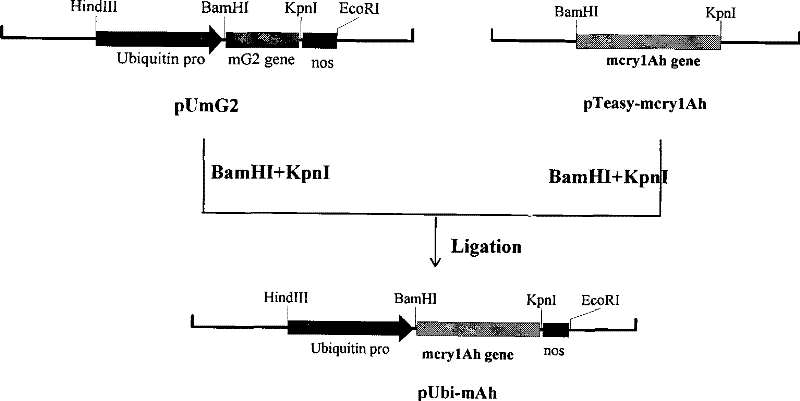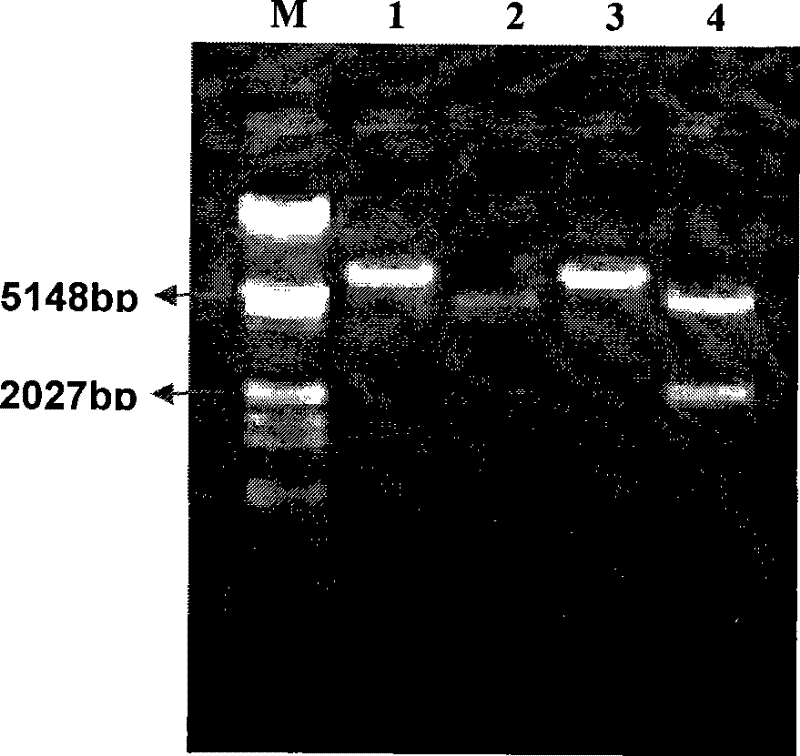Artificially synthetic high gene sequence expressing high virulence protein for lepidoptera pest and use thereof
A gene sequence, artificial synthesis technology, applied in applications, plant genetic improvement, microorganism-based methods, etc., can solve problems such as reduced protein translation efficiency, abnormal mRNA splicing, and unstable expression products.
- Summary
- Abstract
- Description
- Claims
- Application Information
AI Technical Summary
Problems solved by technology
Method used
Image
Examples
Embodiment 1
[0081] Example 1 Transformation and synthesis of cry1Ah gene for common plant transformation
[0082] According to the amino acid sequence (SEQ NO.1) of the cry1Ah gene (Chinese patent, patent number: 200410009918.9), the present invention first adopts plant optimized codons to pair the 1-2001bp sequence (SEQ NO. NO.2) Carry out artificial optimization and transformation. The rare plant codons were avoided as far as possible, and the codon usage frequency was adjusted (Table 1), so that the codon usage frequency of Cry1Ah protein was close to the usage frequency in plants (Table 1). On this basis, the typical AT-rich sequences that cause instability of plant gene transcripts in the DNA sequence were removed, and the hairpin structure and common restriction enzyme sites were removed, in order to form a In NcoI (CCATGG), an amino acid (glycine, GGA) was added after the first start codon, and the nucleotide sequence obtained was SEQ NO.3. The homology between this sequence and ...
Embodiment 2
[0087] Embodiment 2, transformation and synthesis of the cry1Ah gene for rice transformation
[0088] According to the codon bias of the rice gene, the present invention optimizes the codon for plants on the mcry1Ah gene. According to the amino acid sequence (SEQ NO.3) of the mcry1Ah gene, under the premise of ensuring that the amino acid sequence remains unchanged, the rice biased codons were used to artificially optimize and transform SEQ NO.3. The codon usage frequency was adjusted so that the codon usage frequency of the Cry1Ah protein was close to that of the rice gene. Finally, it was determined that the nucleotide sequence of the further modified mcry1Ah gene, that is, the mrcry1Ah gene, was shown in SEQ ID NO.7. For the convenience of subsequent gene manipulation, BamHI sites were added on both sides of the artificially synthesized gene. Finally, the nucleotide sequence of the further modified mcry1Ah gene, namely the mrcry1Ah gene, was determined, as shown in SEQ NO....
Embodiment 3
[0093] Embodiment 3, expression of mcry1Ah gene and mrcry1Ah gene in Escherichia coli
[0094] Using the pTeasy-mcry1Ah plasmid as a template, a 2Kb PCR product was amplified with specific primers, recovered and purified, digested with BamHI and Sal I, and treated with the same pET-21b plasmid (commonly used plasmids, which can induce expression in Escherichia coli). Source gene, which can be purchased at Novagen Company) was connected, transformed into E.coli JM110, and identified by restriction analysis and PCR ( Figure 7 ), screen out positive recombinants, and name the obtained recombinant expression vector plasmid pET-1Ahp.
[0095] The recombinant plasmid pET-1Ahp was transformed into Escherichia coli BL21, 150rpm, 18°C to induce the expression of the target protein, sonicated, centrifuged, and the supernatant and precipitate were respectively taken for SDS-PAGE (8%) analysis ( Figure 8 ). The mcry1Ah gene can be expressed in E. coli.
[0096] The same procedure w...
PUM
 Login to View More
Login to View More Abstract
Description
Claims
Application Information
 Login to View More
Login to View More - R&D
- Intellectual Property
- Life Sciences
- Materials
- Tech Scout
- Unparalleled Data Quality
- Higher Quality Content
- 60% Fewer Hallucinations
Browse by: Latest US Patents, China's latest patents, Technical Efficacy Thesaurus, Application Domain, Technology Topic, Popular Technical Reports.
© 2025 PatSnap. All rights reserved.Legal|Privacy policy|Modern Slavery Act Transparency Statement|Sitemap|About US| Contact US: help@patsnap.com



